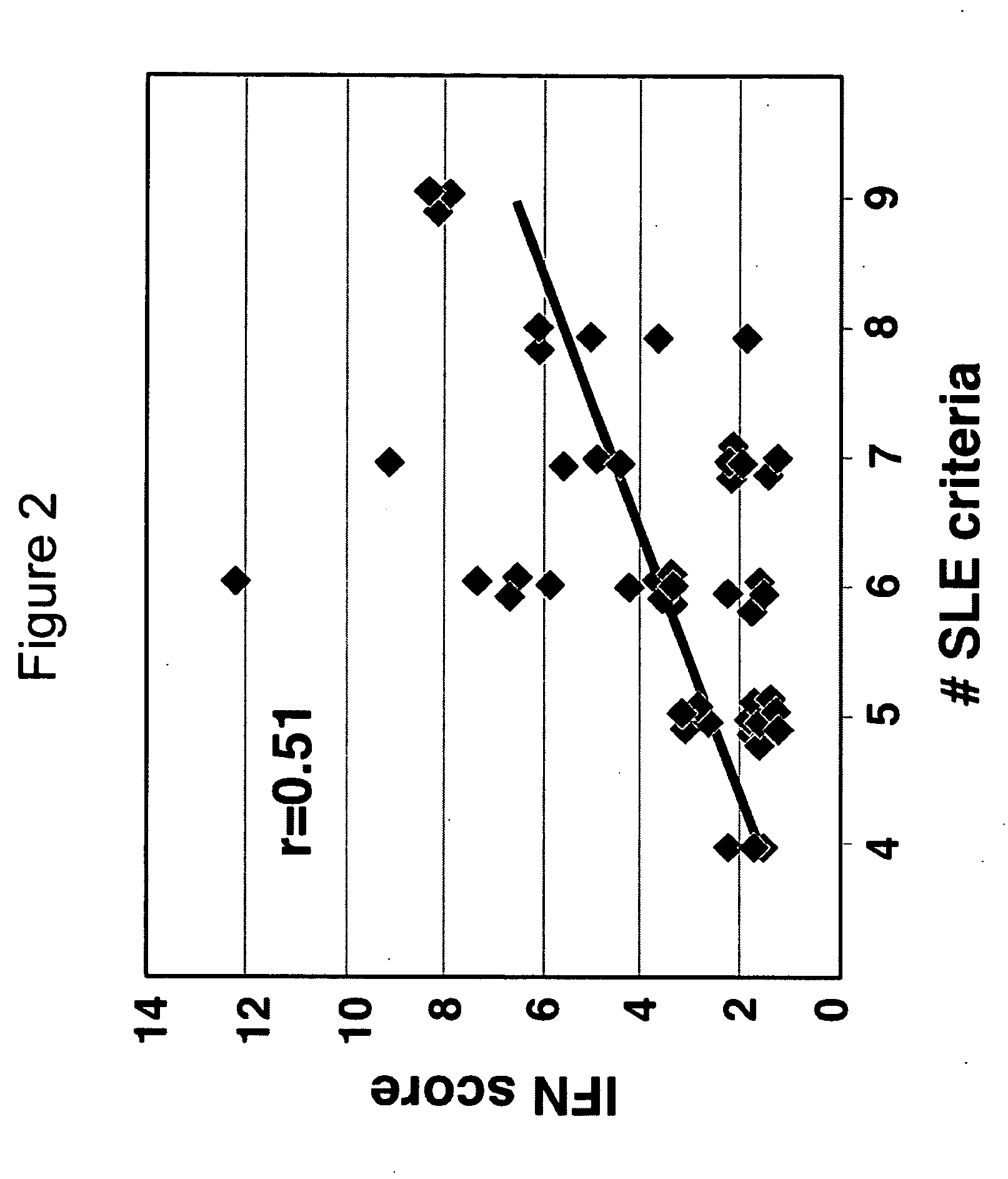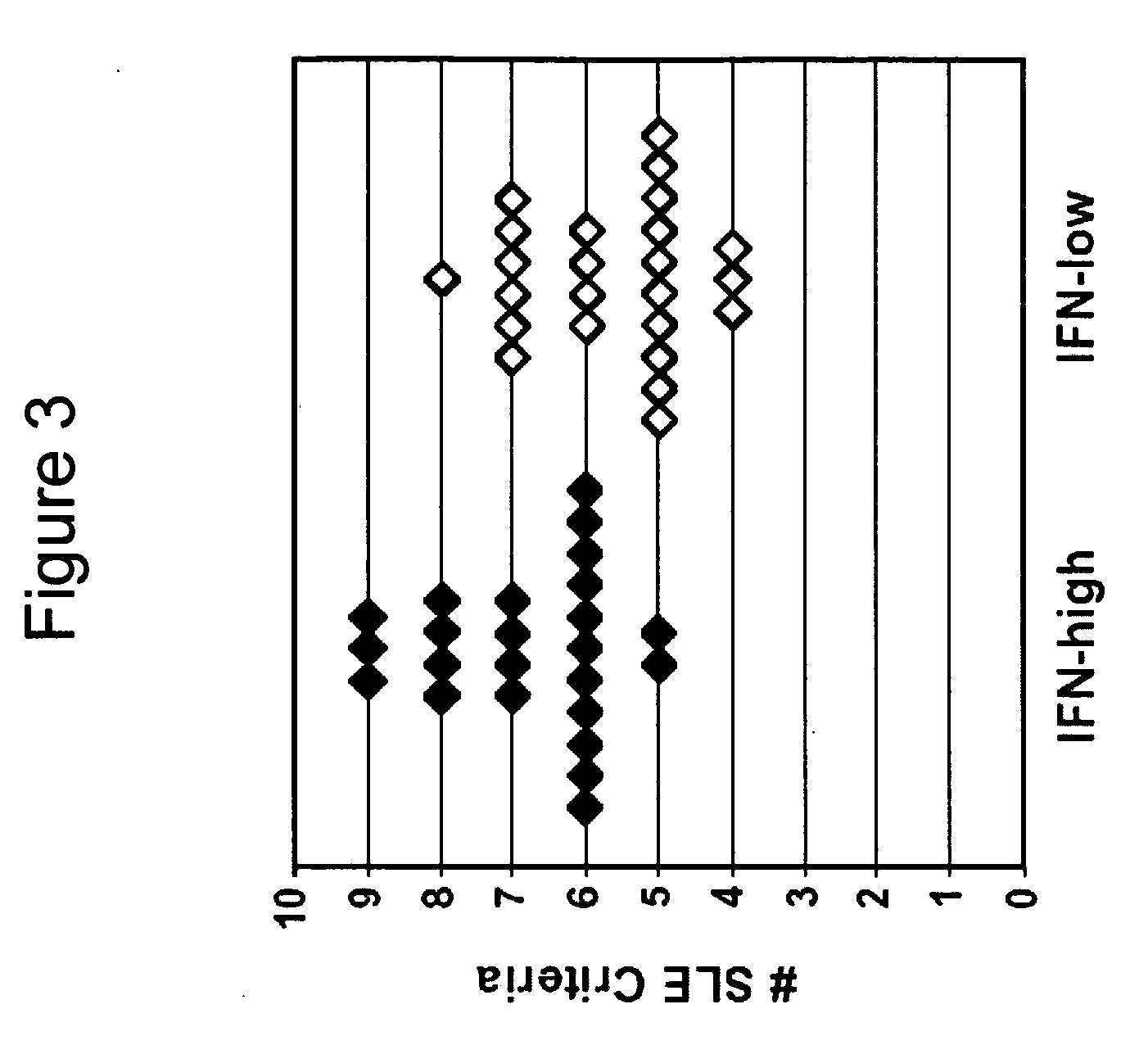Systemic lupus erythematosus
a technology of systemic lupus and erythematosus, applied in the field of systemic lupus erythematosus diagnosis, can solve problems such as the difficulty of diagnosis and management of lupus, and achieve the effects of improving the health and quality of life of patients, reducing or relieving sle symptoms, and improving the patient's quality of li
- Summary
- Abstract
- Description
- Claims
- Application Information
AI Technical Summary
Benefits of technology
Problems solved by technology
Method used
Image
Examples
example 1
Identifying Genes That Can Be Used to Diagnose SLE
[0065] PBMCs were collected from 48 SLE patients and 42 healthy, age- and gender-matched control individuals. All patients had physician-verified SLE and met at least four of the eleven ACR criteria for lupus. The average age of SLE patients was 45±11 years, and the average age of controls was 34±13 years. Each PBMC sample contained monocytes / macrophages, B and T lymphocytes, and natural killer cells.
[0066] For the first 11 patients and 11 controls, poly A+ mRNA was extracted from the collected PBMC samples. Briefly, 60 mL of peripheral blood was drawn into a heparinized syringe. Whole blood was layered over an equal volume of Histopaque and centrifuged at 400× g for 30 minutes at 25° C. Plasma was harvested and stored at −80° C. PBMCs were harvested and washed twice in 1× PBS, and the mRNA was isolated using a FastTrack mRNA isolation kit (Invitrogen, Carlsbad, Calif.).
[0067] For the next 37 patients and 31 controls, total RNA wa...
example 2
Identifying Additional Genes That Can Be Used to Diagnose SLE
[0098] Study participants: Patients were enrolled from the lupus clinic at Johns Hopkins University Medical Center (Petri et al. (1991) Arthritis Rheum. 34:937-944). All SLE patients had physician-verified SLE and were evaluated by the same examining physician. After informed consent, patients provided a peripheral blood sample. Blood for RNA extraction was collected into PaxGene tubes (PreAnalytiX, Hombrechtikon, Switzerland).
[0099] Sample Processing and Chip Hybridization: RNA was extracted using the PaxGene Blood RNA System (PreAnalytix). Five μg of total RNA was used to prepare biotinylated cRNA for hybridization using the standard Affymetrix protocol (Expression Analysis Technical Manual, Affymetrix, Santa Clara, Calif.). For seven samples with low RNA yields, two rounds of amplification were performed. Fifteen micrograms of each labeled cRNA was hybridized to Affymetrix U133A Human GeneChips.
[0100] Data Processing...
example 3
Identifying Genes That Can Be Used to Monitor and Predict SLE Activity
[0135] Collection of specimens for a human lupus biorepository was initiated. This study was designed to identify biomarkers for SLE. A lupus biorepository contains samples collected from the Hopkins Lupus Cohort Study (Petri et al., Arthritis Rheum 34:937-44 (1991)), in which over 1,000 SLE patients are being followed, with clinic visits scheduled every three months. This study was designed to follow 300 patients for one year, including collection of clinical data and blood and urine samples at each visit during the enrollment year. The repository currently contains samples from over 1,350 individual patient visits of 297 enrolled SLE patients.
[0136] Study participants, clinical data, and biological specimens: Informed consent was obtained from each participant. A comprehensive medical history taken during the first visit of the study included a baseline SLICC / ACR damage index, which scores irreversible organ d...
PUM
| Property | Measurement | Unit |
|---|---|---|
| clinical heterogeneity | aaaaa | aaaaa |
| frequency | aaaaa | aaaaa |
| northern blotting | aaaaa | aaaaa |
Abstract
Description
Claims
Application Information
 Login to View More
Login to View More - R&D
- Intellectual Property
- Life Sciences
- Materials
- Tech Scout
- Unparalleled Data Quality
- Higher Quality Content
- 60% Fewer Hallucinations
Browse by: Latest US Patents, China's latest patents, Technical Efficacy Thesaurus, Application Domain, Technology Topic, Popular Technical Reports.
© 2025 PatSnap. All rights reserved.Legal|Privacy policy|Modern Slavery Act Transparency Statement|Sitemap|About US| Contact US: help@patsnap.com



